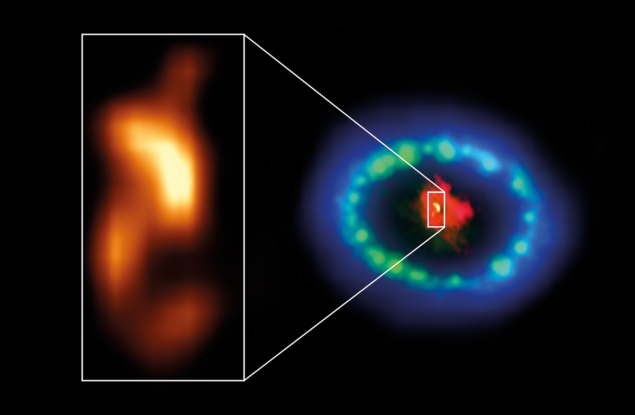
On 23 February 1987 astronomers around the world saw an extremely bright supernova, now called SN1987A. It was the closest supernova observed for over 300 years and was visible to the naked eye. The event was quickly confirmed to be the result of the collapse of “Sanduleak –69 202”, a blue supergiant star in the Large Magellanic Cloud. As the first nearby supernova in the era of modern astronomy, SN1987A remains one of the most monitored objects in the sky. Apart from confirming several important theories, such as radioactive decay being the source of the observed optical emission, the supernova also raised a number of questions that remain unanswered. The most important is: where is the remnant of the progenitor star?
Despite several false detection claims in the past, evidence is mounting that Sanduleak –69 202 collapsed into a neutron star
Despite several false detection claims in the past, evidence is mounting that Sanduleak –69 202 collapsed into a neutron star that is becoming more visible as the dust around it starts to settle. A new analysis by researchers in Italy and Japan based on high-energy X-ray data from the Chandra and NuSTAR space telescopes adds the latest support to this idea.
Even before the optical light from SN1987A was detected, several neutrino detectors around the world saw a burst of neutrinos. The brightest one was observed by Japan’s Kamiokande II detector, which detected a total of 12 antineutrinos approximately three hours before the first optical light reached Earth. The detection of antineutrinos seemed to confirm theoretical predictions for a star the size of Sanduleak –69 202: namely that it should collapse into a neutron star, and emit large numbers of neutrinos while doing so. The optical light arrives later because it is only produced when the shock waves from the collapse reach the surface of the star.
Since the newly formed neutron star would be expected to emit large amounts of energy at various wavelengths, one might assume it would be relatively easy to detect. However, no signs were found in follow-up searches over the past three decades, leading to much speculation about the fate of this star and its surrounding medium.
The first signs of the stellar remnants of SN1987A came from radio observations by the Atacama Large Millimeter/submillimeter Array (ALMA) in Chile in 2019. A group led by Phil Cigan from Cardiff University in the UK used ALMA data at various frequencies to study the core of SN1987A. Close to the centre, they found a bright “blob” structure, the emission from which appeared to be compatible with radio emission from particles accelerated by a neutron star, also called a pulsar wind nebula. Although the researchers could not exclude local heating from 44Ti produced during the supernova as the source, the results provided the first hint that the blob houses a young neutron star.
Wind power
Inspired by the ALMA results, Emanuele Greco from the University of Palermo and coworkers started to study the same region using X-ray data from Chandra and NuSTAR taken during 2012, 2013 and 2014. They found that the detected soft X-ray emission (0.5–8 keV) was compatible with thermal emission produced in the remnant shock waves of the supernova event with the circumstellar medium. However, at higher energies (10–20 keV) the emission was clearly non-thermal in nature. Describing their findings in a preprint posted in January, the group studied the two possible sources for such emission: synchrotron emission from a pulsar wind nebula and synchrotron emission produced in shock waves in the region. Whereas models for both ideas fit the spectral data, the pulsar wind nebula is favoured because the shock emission would not be expected to look like this for such a young remnant.
It appears that after 34 years of searching we will finally understand what happened in SN1987A
The reason why this neutron star has escaped previous observations in optical or soft X-ray energies is likely absorption by cold dust emitted during the supernova, which appears to still absorb a large part of the synchrotron emission observed in X-rays, especially at lower energies. But the dust is expected to start to heat up during the coming decades, thereby becoming transparent to lower energy emission. Greco and colleagues predict that, if the emission is indeed induced by a neutron star, it will become visible in the soft X-ray regime by 2030 with Chandra.
Although astronomers have just two observational hints that Sanduleak –69 202 did, as it should according to theory, collapse into a neutron star, it appears that after 34 years of searching we will finally understand what happened in SN1987A.
Further reading
P Cigan et al. 2019 ApJ 886 51
E Greco et al. 2021 arXiv:2101.09029 (accepted by ApJL).





